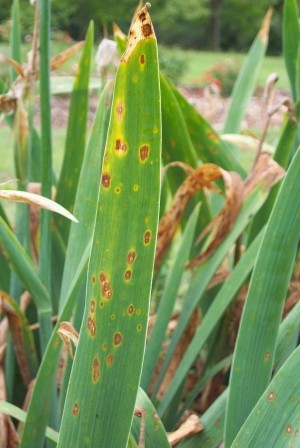Iris Leaf Spot
 Causal Agent
Causal Agent
Didymellina macrospora
Hosts
Iris. A widespread, serious disease of iris is a leaf spot caused by the fungus Didymellina macrospora. This disease occurs on leaves of several species of iris (including the bulbous types), narcissus, and certain other ornamentals, but is a major problem only on the commonly grown, rhizomatous species of iris, Iris germanica. It may seem that the small spots on the leaves do not do much damage, but when infected plants are compared with those that are disease-free, it is evident that the disease does cause premature death of foliage and reduction in plant vigor. When infection is heavy, rhizome growth is reduced and plants become more subject to cold damage.
Symptoms
The first evidence of the disease is the appearance of very small brown spots surrounded by water-soaked margins that later turn yellow. Spots occur on either surface of leaves and enlarge slowly during spring and early summer.After plants bloom, spots enlarge more rapidly and coalesce. These spots produce a mass of spores which are responsible for disease buildup during the growing season and which are spread by rain or splashing water to other leaves.
The fungus lives through the winter on dead leaves that are infected the previous summer. During warm spring weather, masses of spores are produced on the old diseased leaves and are splashed to the new foliage to start the disease again.
Control
Removal of dead leaves from iris beds in the fall or winter will reduce disease level. When leaf spot severity is high, applications of fungicide in addition to sanitary measures will aid control. Contact your local county extension office for current information.

